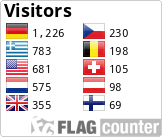An earthquake (also known as a quake, tremor or temblor) is the perceptible shaking of the surface of the Earth, resulting from the sudden release of energy in the Earth's crust that creates seismic waves. Earthquakes can be violent enough to toss people around and destroy whole cities. The seismicity or seismic activity of an area refers to the frequency, type and size of earthquakes experienced over a period of time.
Earthquakes are measured using observations from seismometers. The moment magnitude is the most common scale on which earthquakes larger than approximately 5 are reported for the entire globe. The more numerous earthquakes smaller than magnitude 5 reported by national seismological observatories are measured mostly on the local magnitude scale, also referred to as the Richter magnitude scale. These two scales are numerically similar over their range of validity. Magnitude 3 or lower earthquakes are mostly imperceptible or weak and magnitude 7 and over potentially cause serious damage over larger areas, depending on their depth. The largest earthquakes in historic times have been of magnitude slightly over 9, although there is no limit to the possible magnitude. Intensity of shaking is measured on the modified Mercalli scale. The shallower an earthquake, the more damage to structures it causes, all else being equal.[1]
At the Earth's surface, earthquakes manifest themselves by shaking and sometimes displacement of the ground. When the epicenter of a large earthquake is located offshore, the seabed may be displaced sufficiently to cause a tsunami. Earthquakes can also trigger landslides, and occasionally volcanic activity.
Greece is located at the complex boundary zone in the eastern Mediterranean between the African Plate and the Eurasian Plate. The northern part of Greece lies on the Eurasian Plate while the southern part lies on the Aegean Sea Plate. The Aegean Sea Plate is moving southwestward with respect to the Eurasian Plate at about 30 mm/yr while the African Plate is subducting northwards beneath the Aegean Sea Plate at a rate of about 40 mm/yr. The northern plate boundary is a relatively diffuse divergent boundary while the southern convergent boundary forms the Hellenic arc.[1]
Geology
The island of Kos is part of a chain of mountains from which it became separated after earthquakes and subsidence that occurred in ancient times. These mountains include Kalymnos and Kappari which are separated by an underwater chasm c. 70 metres (230 ft) (40 fathoms deep), as well as the volcano of Nisyros and the surrounding islands.
The strongest earthquakes historically are those associated with the Hellenic Arc, although none larger than about 7.2 have been observed instrumentally. The events of AD 365 and 1303 are likely to have been much larger than this. In mainland Greece, normal faulting gives earthquakes up to 7 in magnitude, while in the northern Aegean, strike-slip events with a magnitude of 7.2 have been recorded. Large intermediate depth (>50 km) earthquakes of magnitude >7 from within the subducting African Plate have been recorded but such events cause little damage, although they are widely felt.
Have a wander around the Archaeological site of the harbour agora here in the centre of Kos and read about the history and of the destruction caused by Earthquakes over the centuries.
There are information boards dotted around the site which will assist you in understanding the Agora and each board will have the answer you require in order to log this Earthcache as a find.
Send to me via my profile your answers to the questions below, but feel free to log your find immediatley. Only if there is a problem with your answers will I request further confirmation and may delete a log if they are not satifactory.
Enbjoy your cultural and geological visit to Kos.
Please note the site is CLOSED on Mondays and will close at 3pm on the days that it is open , I don't want anyone getting thrown out before having their full walk into the past and have your visit spoilt.
You may log your find immediately as stated but for Earthcache guide lines you must answer the following questions and send the answers via my profile as soon as possible.
1 The Sanctuary remained unchanged until what year and why?
2 The new city of Kos was founded in what year?
3 Considered one of the largest Basilicas in the 5th-6th Century AD What were the dimensions in meters?
4 (a) How many buildings occupied within the 350 meter Agora? (b) Which Earthquake caused extensive damage to the Agora?
5 In the 6th Century AD a large basilica was built upon the remains of the stoa, but tell me in what year did an earthquake destroy the Harbour Quarter?
6 What church was built on the remnants of Hercules temple?
7 On what date was the earthquake that allowed extensive excavations bringing to light a large part of the ancient city?
8 (a) In what year was the fortification of a 3KM wall erected? (b) Which Earthquake caused it's demise?
9 A simple observation question. What animal can be seen in the mosaic?
10 Using the information provided. Tell me what evidence is there of Seismic activity on the island of Kos? (You may want to check your GPS)
11 Not a requirement and purely optional, upload a photograph of yourself at the site.
